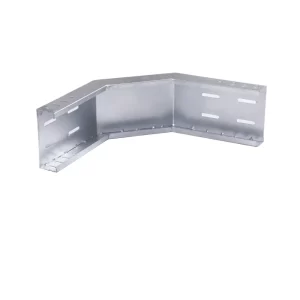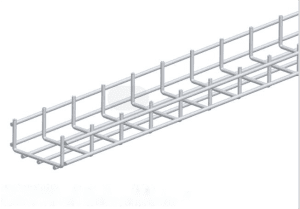Cable trays come in a variety of sizes to accommodate different cable capacities, installation environments, and load-bearing requirements. There isn’t a single universal “standard” size, but rather a range of standard dimensions defined by various standards and regulations, with the most common ones adhering to international or national standards such as those set by the National Electrical Code (NEC) in the United States or International Electrotechnical Commission (IEC) standards globally.

Standard Widths
Cable tray widths typically range from 100mm (3.94 inches) to over 1000mm (39.37 inches), with common increments in between such as 150mm, 200mm, 300mm, 400mm, 600mm, and 800mm. The width chosen depends on the number and size of cables to be installed, as well as the voltage rating and spacing requirements for the cables to avoid overheating and to facilitate maintenance.
Standard Depths
Depth is another critical dimension, affecting both the capacity to hold cables and the tray’s structural integrity. Common depths range from 50mm (1.97 inches) to over 300mm (11.81 inches), with increments in steps like 75mm, 100mm, 150mm, and 200mm. Deeper trays are used for larger diameter cables or to accommodate a higher volume of cables.
Height or Side Rail Heights
While not typically referred to as a “size,” the height of the side rails is important for cable retention and protection. This measurement can vary but usually ranges from 50mm to 75mm for typical applications.
Types of Cable Trays and Their Sizes
Ladder Type: Ladder trays consist of two longitudinal side rails connected by rungs. They are available in a wide range of widths and depths as mentioned above.
Solid Bottom (Trough or Channel): Solid bottom trays provide a covered surface for cables and are available in similar width and depth options as ladder types, with depths typically starting at 50mm and increasing in increments.
Wire Mesh: Wire mesh trays are more open, promoting air circulation. They also follow a similar sizing pattern but with wire mesh instead of solid sides or rungs.
Single Rail or Cable Basket: These types are more specialized and are characterized by a single rail or basket-like structure. Their dimensions vary greatly based on design, but they are typically chosen for specific cable management needs in limited spaces.

Choosing the Right Size
Selecting the correct cable tray size requires careful consideration of several factors:
Cable Diameter and Quantity: Measure the diameter of the largest cable and calculate the total cross-sectional area of all cables to be placed in the tray.
Spacing Requirements:Follow industry standards and local codes for minimum clearances between cables and around tray edges to prevent overheating and facilitate cable addition or removal.
Load Capacity: Ensure the tray can bear the combined weight of the cables plus any additional loads (snow, ice, etc.) based on the installation environment.
Installation Space: Consider the available space for installation, including vertical and horizontal clearances, as well as any obstructions.
It’s always advisable to consult the manufacturer’s recommendations, applicable standards, and engage a professional to assess your specific cable management needs to determine the most appropriate cable tray size for your project.
standard cable tray sizes
In the world of electrical installations, cable trays play a crucial role in supporting and protecting cables. They provide a secure pathway for cables and wires across industrial, commercial, and residential environments. This article aims to guide you through the intricacies of standard cable tray sizes, helping you make informed decisions for your projects.
Understanding Cable Tray Types
Before diving into sizes, it’s important to recognize the various types of cable trays available. Each type serves distinct purposes and is suited to different applications.
Ladder Cable Trays
Ladder cable trays are designed with two side rails connected by rungs. They are ideal for supporting large quantities of cables, allowing heat dissipation and easy access for maintenance. The ladder design also facilitates the installation of cables at different points along the tray.
Wire Mesh Cable Trays
Wire mesh cable trays sometimes referred to as basket trays, are made from a grid of metal wires. They are lightweight and versatile, making them a popular choice for telecom and data installations. The open structure allows for excellent ventilation and cable visibility.
Solid Bottom Cable Trays
Solid bottom cable trays provide a continuous surface, offering maximum protection for cables from external elements. They are commonly used in situations where cable droppings need to be contained or where there are concerns about electromagnetic interference.
Trough Cable Trays
Trough cable trays are similar to solid bottom trays but have a ventilated bottom, which allows for better heat dissipation. They strike a balance between protection and ventilation, making them suitable for a wide range of installations.
Standard Cable Tray Sizes
Understanding standard cable tray sizes is essential for selecting the right tray for your installation. Here, we’ll explore the dimensions that are commonly used in the industry.
Width
The width of a cable tray is a critical factor, as it determines how many cables it can accommodate. Standard widths range from 50mm to 900mm. The choice of width depends on the volume of cables to be supported and the available installation space.
50mm – 100mm: Suitable for small installations with a limited number of cables.
150mm – 300mm: Ideal for medium-sized installations in commercial settings.
450mm – 900mm: Used in industrial environments with a high density of cables.
Height
Cable tray height is another important dimension that influences cable capacity. Standard heights typically range from 25mm to 150mm. Taller trays can support more cables and provide better protection.
25mm – 50mm: Common in light-duty installations.
75mm – 100mm: Used for medium-duty applications.
150mm: Preferred in heavy-duty industrial settings.
Length
Standard cable trays are usually available in lengths of 2.5 meters to 3 meters. Longer trays reduce the number of joints needed, minimizing the potential for weak points in the installation.
Cable Tray Support Channel Size
The support channel is essential for securing cable trays in place. Standard sizes for support channels vary based on the tray type and the load it needs to bear. They are typically designed to fit the specific dimensions of the cable tray being used.
Common Support Channel Sizes
41mm x 41mm: Suitable for light to medium-duty installations.
41mm x 21mm: Often used in lighter-duty applications or where space is limited.
Heavy-Duty Channels: Designed to provide extra support for large and heavy cable trays.
Cable Tray Sizing Considerations
When selecting a cable tray size, several factors must be taken into account to ensure a successful installation.
Cable Volume and Type
Determine the number and type of cables you need to support. Consider future expansion to avoid the need for costly upgrades.
Installation Environment
Consider the environmental conditions where the cable tray will be installed. Factors such as temperature, humidity, and potential exposure to chemicals can influence material choice and tray design.
Load Capacity
Ensure the cable tray can support the weight of the cables it will carry, including any additional loads such as snow or wind if installed outdoors.
Accessibility and Maintenance
Consider how easy it will be to access the cables for maintenance and repairs. This can influence the choice of tray type and size.
Conclusion
Selecting the right cable tray size is a crucial step in any electrical installation project. By understanding the different types of cable trays and their standard sizes, you can make informed decisions that ensure efficiency, safety, and longevity in your installations. Whether you’re working on a small commercial project or a large industrial installation, choosing the appropriate cable tray will support your cables effectively and protect them from damage.
As always, consult with industry professionals and adhere to local regulations and standards to ensure your cable tray installation meets all requirements. With the right knowledge and planning, your cable management system will be robust and reliable, serving your needs for years to come.

